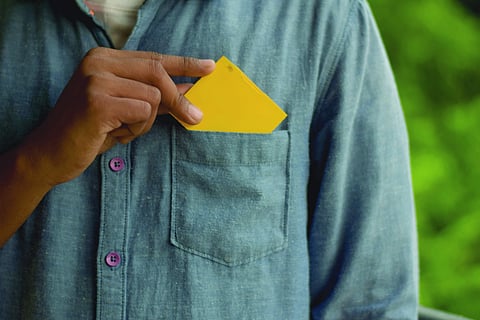

The idea of Drishti is so simple yet so novel that we had to do a double-take the first time Mani Teja Lingala tried to explain it to us. We are sure the good folk screening candidates for the James Dyson Award, an international student award, were equally baffled. No wonder the idea is one of the runners-up to the prestigious award.
Designed by students of National Institute of Design (NID), Ahmedabad, Mrudul Chilmulwar and Mani Teja, Drishti helps the visually-impaired identify currency notes in two simple steps. "Those who are visually-impaired had their own tricks to identify notes initially and then came demonetisation, complicating matters further for them," explains Mani Teja who hails from Yernagudem, a village in the West Godavari district of Andhra Pradesh. And they inferred this while doing their research and talking to the Blind People's Association in Ahmedabad. "The new notes are all different in terms of size which makes the task of identifying them even more difficult," explains the 29-year-old. And that's when the idea of Drishti came to Mani Teja and Mrudul who have their own studio in Ahmedabad and Amsterdam, named Studio Carbon.
Drishti itself is a simple template, made from polypropylene plastic sheets. Think of the template as a simple sheet against which, when currencies are placed, they can be identified. With the various cuts made in the template, the notes identification becomes even simpler by using just two parameters — width and height. When notes are sized up against the template, if the width goes beyond the template, it is an old note. Now, when it comes to categorisation with the help of height that tells you the denomination, the template has different edges (think of them as steps) at the top that makes identification of notes on the basis of height. "This is not just simple, it is a cost-effective approach because the cost of the template is below five rupees," says Mani Teja who was brought up in Hyderabad. The best part? There is no Braille involved. "About 60 per cent of the visually-impaired, especially those from rural areas, don't know Braille. So Drishti can really serve the purpose for them as well," he explains.
There is a short course called Design for Special Needs at NID where they need to identify a problem statement and then come up with a solution. That's when the idea occurred to them, reveals Mani Teja who graduated in March this year. "We spoke to several visually-impaired people and tried out about five to six solutions before actually zeroing in on this one," he explains. This idea also made them finalists at the Lexus Design Award 2020 and they were felicitated by the Blind People's Association as well. Way to go!
Steps to follow to use Drishti
1. Place the note in the left-bottom corner of the template and align it to the left and bottom edges of the template to identify if it’s an old or a new note
2. Check the height of the note in reference to the steps of the template to identify the denomination of the note
